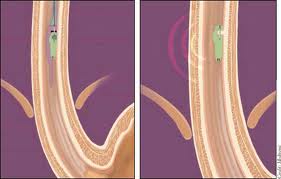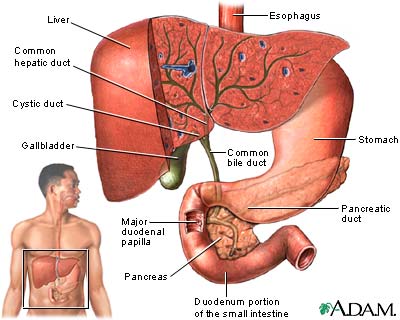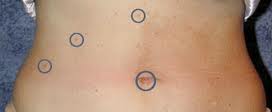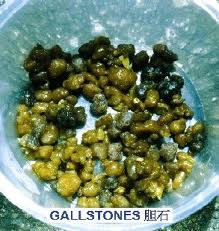

What does Bravo have to do with gastro-esophageal reflux disease?? Well, let's investigate it a little.
What is GERD (gastro-esophageal reflux disease)?? Here is a good definition:
GERD is characterized by symptoms and/or tissue damage that results from repeated or prolonged exposure of the lining of the esophagus to acidic contents from the stomach and occurs when the lower esophageal sphincter (LES) does not seal off the esophagus from the stomach.
The two most frequently reported symptoms of GERD are heartburn, which can be described as a burning discomfort that begins behind the breastbone and radiates to the neck and throat, and acid regurgitation, which is characterized as a bitter, sour tasting fluid. One out of five people experience heartburn or acid regurgitation on a weekly basis and two out of five people experience heartburn or acid regurgitation at least once a month.
 This is a good depiction of how reflux occurs. The esophagus is not prepared to handle the exposure to acid that the stomach is. The "heartburn" that can occur is normal on occasion, but if it occurs frequently, it can cause changes in the lining of the esophagus... esophagitis. Besides the symptoms this can cause, I.E. heartburn, chest pain, hoarseness, coughing, bad breath, inability to sleep, it can cause strictures in the esophagus, difficulty swallowing, and changes in the cellular lining that can be dangerous.
This is a good depiction of how reflux occurs. The esophagus is not prepared to handle the exposure to acid that the stomach is. The "heartburn" that can occur is normal on occasion, but if it occurs frequently, it can cause changes in the lining of the esophagus... esophagitis. Besides the symptoms this can cause, I.E. heartburn, chest pain, hoarseness, coughing, bad breath, inability to sleep, it can cause strictures in the esophagus, difficulty swallowing, and changes in the cellular lining that can be dangerous.
Fortunately, today, we have medicines that are very effective in reducing the acid and the symptoms that it causes. These medications are readily available, even over the counter, but, they are not meant to be used for a long time. They also have a dark side. PPI (proton pump inhibitors) like prilosec, nexium, etc., when taken for the long term can cause calcium leaching from the bone leading to osteoporosis or thinning of the bones. They can also cause changes in the lining of the stomach leading to polyp formation. They can also be very expensive!!
So, what can be done about this!! When I see a patient with symptoms of reflux, the first thing we like to do is document any changes to the baseline by looking with a scope...an EGD. This allows us to look and biopsy to establish any changes. The procedure takes about 15 minutes under sedation...pretty easy. We then start a trial of medication which usually works. It is recommended that the trial is relatively short...a few months... If symptoms persist we will then schedule for a BRAVO pH monitoring test after being off of the meds for about a week. This allows us to rule out other causes for the symptoms you are experiencing. The Bravo is a small monitor that adheres to the esophagus for a few days and monitors the acidity. You keep a journal of symptoms while we monitor...symptoms and acid=a positive test.

With a positive test, changes in the esophagus, and symptoms on the medication, we recommend a laparoscopic repair. This is called a Nissen Fundoplication (hiatal hernias are also repaired at the same time). If the medications alleviate the symptoms, and you have been on them a long time....we have to decide if surgery is appropriate. Considering the fact that the medications can cause problems, if you are healthy, patients usually opt for fixing the problem to get off of them medication.
The success rate for the Nissen is about 90%, as reported in the literature....there are not many treatments that have statistics that good!! You will usually spend one night in the hospital and are back to normal in a couple of weeks with only small (1/4 inch) incisions.

So, the Bravo is a great test to help us figure out if the symptoms you are having are actually caused by your GERD....that's important. The worst thing we can do is fix your reflux and later find out your symptoms are from something else!!
Come see us today if you have reflux that does not respond to medications, or, if you have been on the meds for some time and cannot live without them...WE can help. We do EGD, Bravo pH testing, AND Nissen Fundoplication, Total Body Surgical!
Call 918-786-7780 or toll free 877-weight0 today for an appointment!!
Don't forget our special pricing on breast enhancement surgery until April 30..what a deal!! Just click on the breast button to see what it's all about. AND our liposuction special pricing too, look great for summer!! Cosmetic consultations are always complimentary!!





 This picture represents a small polyp that is non malignant.
This picture represents a small polyp that is non malignant. If left unchecked the small polyp above can become the large cancer that you see here.
If left unchecked the small polyp above can become the large cancer that you see here. This picture illustrates the presumed progression of polyps from a small benign problem to a cancer. Of course polyps are not the only thing we look for. Inflammatory bowel disease and other problems are also detected with this test.
This picture illustrates the presumed progression of polyps from a small benign problem to a cancer. Of course polyps are not the only thing we look for. Inflammatory bowel disease and other problems are also detected with this test.


 Here is a picture of gallstones....not too pretty.
Here is a picture of gallstones....not too pretty. We can live normally without a gallbladder in most cases, especially a sick one. Some people may experience a little diarrhea that usually resolves but most importantly, the pain is gone. If the disease is not treated, the stones can escape the gallbladder and get into the duct causing bigger problems that we won't discuss here. The gallbladder can also become infected which can be an emergency.
We can live normally without a gallbladder in most cases, especially a sick one. Some people may experience a little diarrhea that usually resolves but most importantly, the pain is gone. If the disease is not treated, the stones can escape the gallbladder and get into the duct causing bigger problems that we won't discuss here. The gallbladder can also become infected which can be an emergency.